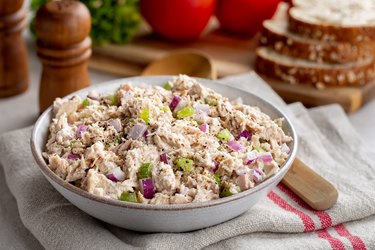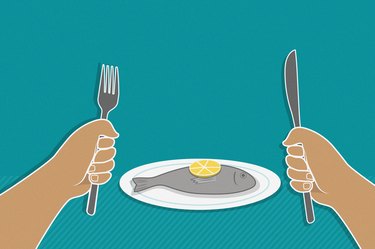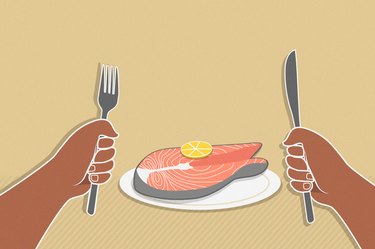
There's nothing like a classic tuna salad sandwich, and the stats back that up: Canned tuna is the third most widely enjoyed type of seafood in the U.S., according to the National Fisheries Institute.
Luckily, canned tuna offers up a bevy of health benefits — as long as you're aware of mercury and sodium concerns.
Video of the Day
Video of the Day
Canned Tuna Nutrition Facts
Oil-Packed White Tuna
Canned tuna's nutritional breakdown depends on how the fish is packed in the can. According to the USDA, a can of white tuna in oil (drained) contains:
- Calories: 331
- Total fat: 14.4
- Cholesterol: 55.2 mg
- Sodium: 705 mg
- Total carbs: 0 g
- Dietary fiber: 0 g
- Sugar: 0 g
- Protein: 47.2 g
Water-Packed White Tuna
A little lighter in calories and fat, but also lower in protein, water-packed canned white tuna contains:
- Calories: 220
- Total fat: 5.1 g
- Cholesterol: 72.2 mg
- Sodium: 648 mg
- Total carbs: 0 g
- Dietary fiber: 0 g
- Sugar: 0 g
- Protein: 40.6 g
- Selenium: 205% Daily Value (DV)
- Vitamin B12: 84% DV
- Vitamin B3 (Niacin): 62% DV
- Phosphorus: 30% DV
- Vitamin B6: 22% DV
- Vitamin D: 17% DV
- Magnesium: 14% DV
- Vitamin E: 10% DV
- Iron: 9% DV
- Potassium: 9% DV
- Zinc: 8% DV
- Copper: 7% DV
Tip
When shopping for canned tuna, you'll see "Chunk light" and "white" options, which refer to the species of tuna.
"Light" tuna is typically skipjack and occasionally yellowfin, while "white" tuna is typically albacore, per the Colorado Integrated Food Safety Center of Excellence. The nutritional differences between white vs. light canned tuna isn't significant but the mercury content can be.
The Health Benefits of Canned Tuna
1. It Supports Heart Health
Fatty fish is one of the best sources of omega-3 fatty acids, and a can of oil-packed tuna contains 14 percent of the recommended daily amount of omega-3s. Your body can't make these essential fats on its own, according to the Cleveland Clinic, so you have to get them through your diet.
Omega-3s are linked to a reduced risk of heart disease, blood clots and inflammation. They can also lower your blood pressure and increase levels of high-density lipoprotein, the "good" cholesterol, per the Cleveland Clinic. And that's all good news for your heart health.
2. It's Tied to Brain Health
Getting enough omega-3s (like by eating tuna) is linked to a lower likelihood of developing Alzheimer's disease or dementia, per the National Institutes of Health (NIH). But more research needs to be done to confirm these findings.
3. It's Good for Your Vision
Age-related macular degeneration can cause vision loss in older adults, and some research suggests that getting enough omega-3s is linked to a lower risk of developing the disease, per the NIH.
However, once a person has age-related macular degeneration, it can't be reversed by eating more omega-3s.
4. It's a Source of Quality Protein
Protein makes up virtually every tissue in your body, so it makes sense your body needs a good amount of it to function at its best.
Eating canned tuna is an inexpensive way to get complete protein, which means it contains all of the essential amino acids your body needs, according to the Harvard T.H. Chan School of Public Health. Beyond that, canned tuna is a "lean" protein, which means it offers up a lot of protein without too much fat.
5. It Can Help Prevent Anemia
Canned tuna is rich in vitamin B12, providing 163 percent of your daily needs.
A vitamin B12 deficiency can lead to megaloblastic anemia, a condition in which your body doesn't have enough healthy red blood cells, according to Johns Hopkins Medicine. This type of anemia can cause weakness, nerve damage, weight loss, irritability, fatigue and an increased heart rate.
But eating tuna regularly can help you avoid being at risk for anemia.
6. It Supports Strong Bones
Both vitamin B12 and protein — two nutrients tuna is rich in — play a role in maintaining strong, healthy bones by reducing the chances of developing osteoporosis, according to the International Osteoporosis Foundation.
Canned tuna has other nutrients — such as vitamin B6, magnesium, vitamin D and zinc — that help build bone mineral density.
7. It's High in Vitamin D
A can of water-packed white tuna has 3.44 micrograms of vitamin D, which is around 23 percent of the recommended daily amount. Most Americans don't get the suggested amount of 15 micrograms of vitamin D per day, according to the NIH.
Getting enough vitamin D is to better heart and bone health.
Canned Tuna Health Risks
1. Mercury
When you eat too much mercury-containing fish, you run the risk of mercury poisoning, which can lead to peripheral vision loss, a "pins and needles" feeling, lack of coordination, speech or hearing impairment and muscle weakness, according to the U.S. Environmental Protection Agency.
This is particularly concerning for children, who run a higher risk of mercury poisoning.
The amount of mercury in tuna varies based on the size of the species. Albacore (sold in cans as white tuna) is larger than skipjack tuna (sold as light tuna). The Environmental Defense Agency and FDA recommend the following limits for tuna intake:
- Canned White/Albacore Tuna
- Children under 6: Up to 3 ounces a month
- Children ages 6 to 12: Up to two 4.5-ounce servings a month
- Adults: 18 to 24 ounces a month (or one 6- to 8-ounce serving three times a month)
- Pregnant people: One 4-ounce serving a week
- Canned Light/Skipjack Tuna
- Children under 6: Up to three 3-ounce servings a month
- Children ages 6 to 12: Up to four 4.5-ounce servings a month
- Adults: 24 to 32 ounces a month (or 6 to 8 ounces a week)
- Pregnant people: Two to three 4-ounce servings a week
Tip
Skipjack tuna (aka light tuna) is lower in mercury than albacore tuna (aka white tuna). That means you can enjoy light tuna a bit more often than you would albacore.
2. Sodium
When you compare non-canned fresh tuna to canned tuna, there's a clear difference in sodium. Three ounces of fresh, cooked skipjack tuna has 2 percent of your DV of sodium while 3 ounces of canned tuna has about 15 percent of your sodium DV, per the USDA.
Consistently eating too much high-sodium tuna can lead to high blood pressure, a condition that affects 90 percent of Americans, according to the American Heart Association.
How to Enjoy Tuna
As long as you monitor how much canned tuna you're eating each week, it can be a nutritious part of your diet. Plus, think about what you're adding to the tuna so you don't go overboard in calories.
- Choose water-packed tuna over oil-packed to save more than 100 calories and 9 grams of fat per can.
- When making tuna salad, experiment with mix-ins. While protein-rich Greek yogurt can be a great substitute for calorie-laden mayo, this Tuna Waldorf Salad recipe uses kefir instead.
- While whole-wheat bread offers up complex carbohydrates and fiber, you could also serve tuna salad on top of vegetables. Try stuffing it into cucumbers, such as in this Tuna Cucumber Boat recipe, or halve miniature bell peppers.
- Tuna is low in fat, but that doesn't mean fat is bad — the fish can be easily paired with other foods loaded in heart-healthy fats, such as in this Stuffed Avocado recipe, for a well-rounded, nutritious meal.
- Cleveland Clinic: "Omega-3 Fatty Acids"
- National Institutes of Health Office of Dietary Supplements: "Omega-3 Fatty Acids"
- Johns Hopkins Medicine: "Vitamin B12 Deficiency Anemia"
- Harvard T.H. Chan School of Public Health: "Protein"
- National Institutes of Health Office of Dietary Supplements: "Vitamin D"
- U.S. EPA: "Health Effects of Exposures to Mercury"
- Environmental Defense Fund: "Mercury Alert: Is Canned Tuna Safe?"
- USDA: "Fish, Tuna, Light, Canned in Water, Drained Solids"
- American Heart Association: "Get the Scoop on Sodium and Salt"
- National Fisheries Institute: "Top 10 List for Seafood Consumption"
- FDA: Eating Fish - What Pregnant Women and Parents Should Know


